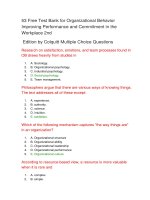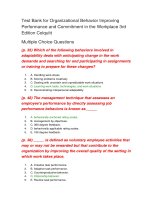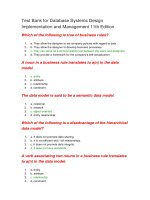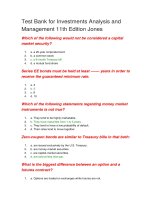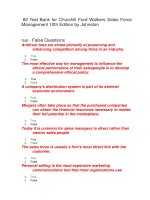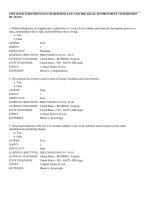Test bank for database systems design implementation and management 11th edition
Bạn đang xem bản rút gọn của tài liệu. Xem và tải ngay bản đầy đủ của tài liệu tại đây (71.66 KB, 12 trang )
Test Bank for Database Systems Design
Implementation and Management 11th Edition
Which of the following is true of business rules?
1.
2.
3.
4.
a. They allow the designer to set company policies with regard to data.
b. They allow the designer to develop business processes.
c. They can serve as a communication tool between the users and designers.
d. They provide a framework for the company’s self-actualization.
A noun in a business rule translates to a(n) in the data
model.
1.
2.
3.
4.
a. entity
b. attribute
c. relationship
d. constraint
The data model is said to be a semantic data model.
1.
2.
3.
4.
a. relational
b. network
c. object-oriented
d. entity relationship
Which of the following is a disadvantage of the hierarchical
data model?
1.
2.
3.
4.
a. It does not promote data sharing.
b. It is not efficient with 1:M relationships.
c. It does not promote data integrity.
d. It does not have standards.
A verb associating two nouns in a business rule translates to
a(n) in the data model.
1.
2.
3.
4.
a. entity
b. attribute
c. relationship
d. constraint
One of the limitations of the model is that there is a lack of
standards.
1.
2.
3.
4.
a. hierarchical
b. network
c. relational
d. entity relationship
In the model, the user perceives the database as a collection
of records in 1:M relationships, where each record can
have more than one parent.
1.
2.
3.
4.
a. hierarchical
b. network
c. object-oriented
d. entity relationship
are normally expressed in the form of rules.
1.
2.
3.
4.
a. Attributes
b. Entities
c. Relationships
d. Constraints
VMS/VSAM is an example of the .
1.
2.
3.
4.
a. hierarchical model
b. file system data model
c. relational data model
d. XML data model
A(n) enables a database administrator to describe schema
components.
1.
2.
3.
4.
a. extensible markup language (XML)
b. data definition language (DDL)
c. unified modeling language (UML)
d. query language
MySQL is an example of the .
1.
2.
3.
4.
a. hierarchical model
b. file system data model
c. relational data model
d. XML data model
A(n) is the equivalent of a field in a file system.
1.
2.
3.
4.
a. attribute
b. entity
c. relationship
d. constraint
A(n) is bidirectional.
1.
2.
3.
4.
a. attribute
b. entity
c. relationship
d. constraint
A(n) is anything about which data are to be collected and
stored.
1.
2.
3.
4.
a. attribute
b. entity
c. relationship
d. constraint
The hierarchical data model was developed in the .
1.
2.
3.
4.
a. 1960s
b. 1970s
c. 1980s
d. 1990s
are important because they help to ensure data integrity.
1.
2.
3.
4.
a. Attributes
b. Entities
c. Relationships
d. Constraints
An internal refers to a specific representation of an internal
model, using the database constructs supported by
the chosen database.
1.
2.
3.
4.
a. tuple
b. schema
c. object
d. value
The object-oriented data model was developed in the .
1.
2.
3.
4.
a. 1960s
b. 1970s
c. 1980s
d. 1990s
Which of the following types of HDFS nodes stores all the
metadata about a file system?
1.
2.
3.
4.
a. Data node
b. Client node
c. Name node
d. Map node
Which of the following is true of NoSQL databases?
1.
2.
3.
a. They do not support distributed database architectures.
b. They are not based on the relational model.
c. They are geared toward transaction consistency rather
4.
d. They do not support very large amounts of than performance. sparse data.
The model is the end users’ view of the data environment.
1.
2.
3.
4.
a. abstract
b. external
c. conceptual
d. internal
The model was developed to allow designers to use a
graphical tool to examine structures rather than
describing them with text.
1.
2.
3.
4.
a. hierarchical
b. network
c. object-oriented
d. entity relationship
NoSQL databases:
1.
2.
3.
4.
a. are geared toward transaction consistency; not performance.
b. support only small amounts of sparse data.
c. are based on the relational model.
d. provide fault tolerance.
The data model uses the concept of inheritance.
1.
2.
3.
4.
a. relational
b. network
c. object-oriented
d. entity relationship
From a database point of view, the collection of data
becomes meaningful only when it reflects properly
defined_____.
1.
2.
3.
4.
a. business rules
b. business norms
c. business goals
d. business plans
Oracle 11g is an example of the .
1.
2.
3.
4.
a. hierarchical model
b. file system data model
c. relational data model
d. XML/Hybrid data model
The relational data model was developed in the .
1.
2.
a. 1960s
b. 1970s
3.
4.
c. 1980s
d. 1990s
A(n) represents a particular type of object in the real world.
1.
2.
3.
4.
a. attribute
b. entity
c. relationship
d. node
Students and classes have a relationship.
1.
2.
3.
4.
a. one-to-one
b. one-to-many
c. many-to-one
d. many-to-many
A(n) is a restriction placed on the data.
1.
2.
3.
4.
a. attribute
b. entity
c. relationship
d. constraint
The model uses the term connectivity to label the
relationship types.
1.
2.
3.
4.
a. relational
b. network
c. object-oriented
d. entity relationship
A(n) ’s main function is to help one understand the
complexities of the realworld environment.
1.
2.
3.
4.
a. node
b. entity
c. model
d. database
In the model, each parent can have many children, but each
child has only one parent.
1.
2.
3.
4.
a. hierarchical
b. network
c. relational
d. entity relationship
Which of the following types of HDFS nodes acts as the
interface between the user application and the HDFS?
1.
a. Data node
2.
3.
4.
b. Client node
c. Name node
d. Map node
In the model, the basic logical structure is represented as an
upside-down tree.
1.
2.
3.
4.
a. hierarchical
b. network
c. relational
d. entity relationship
Total Points: 0 co
20 Free Test Bank for Database Systems Design
Implementation and Management 11th Edition
Coronel True - False Questions
A data model is usually graphical.
1.
2.
True
False
In the context of data models, an entity is a person, place,
thing, or event about which data will be collected and
stored.
1.
2.
True
False
Database designers determine the data and information that
yield the required understanding of the entire
business.
1.
2.
True
False
Business rules apply to businesses and government groups,
but not to other types of organizations such as
religious groups or research laboratories.
1.
2.
True
False
A disadvantage of the relational database management
system (RDBMS) is its inability to hide the
complexities of the relational model from the user.
1.
2.
True
False
M:N relationships are not appropriate in a relational model.
1.
2.
True
False
Within the database environment, a data model represents
data structures with the purpose of supporting a
specific problem domain.
1.
2.
True
False
Even when a good database blueprint is available, an
applications programmer’s view of the data should
match that of the manager and the end user.
1.
2.
True
False
Each row in the relational table is known as an entity
instance or entity occurrence in the ER model.
1.
2.
True
False
An implementation-ready data model should contain a
description of the data structure that will store the enduser data.
1.
2.
True
False
In Chen notation, entities and relationships have to be
oriented horizontally; not vertically.
1.
2.
True
False
The relational model is hardware-dependent and softwareindependent.
1.
2.
True
False
Business rules must be rendered in writing.
1.
2.
True
False
An implementation-ready data model needn't necessarily
contain enforceable rules to guarantee the integrity of
the data.
1.
2.
True
False
In an SQL-based relational database, each table is dependent
on every other table.
1.
2.
True
False
The hierarchical model is software-independent.
1.
2.
True
False
In an SQL-based relational database, rows in different tables
are related based on common values in common
attributes.
1.
2.
True
False
The external model is the representation of the database as
“seen” by the DBMS.
1.
2.
True
False
The network model has structural level dependence.
1.
2.
True
False
Today, most relational database products can be classified
as object/relational.
1.
2.
True
False
20 Free Test Bank for Database Systems Design
Implementation and Management 11th Edition
Coronel Free Text Questions
Each row in the relational table is known as a(n) .
Answer Given
entity instance
A(n) is the conceptual organization of an entire database as
viewed by a database administrator.
Answer Given
schema
Describe the three parts involved in any SQL-based
relational database application.
Answer Given
From an end-user perspective, any SQL-based relational database application
involves three parts: a user interface, a set of tables stored in the database, and
the SQL “engine.” Each of these parts is explained below: The end-user interface.
Basically, the interface allows the end user to interact with the data (by
automatically generating SQL code). Each interface is a product of the software
vendor’s idea of meaningful interaction with the data. You can also design your
own customized interface with the help of application generators that are now
standard fare in the database software arena; A collection of tables stored in the
database. In a relational database, all data are perceived to be stored in tables.
The tables simply “present” the data to the end user in a way that is easy to
understand. Each table is independent. Rows in different tables are related by
common values in common attributes; SQL engine. Largely hidden from the end
user, the SQL engine executes all queries, or data requests. Keep in mind that the
SQL engine is part of the DBMS software. The end user uses SQL to create table
structures and to perform data access and table maintenance. The SQL engine
processes all user requests—largely behind the scenes and without the end user’s
knowledge. Hence, SQL is said to be a declarative language that tells what must
be done but not how.
In objectoriented terms, a(n) defines an object’s behavior.
Answer Given
method
In , a threepronged symbol represents the “many” side of the
relationship.
Answer Given
Crow’s Foot notation
Describe the conceptual model and its advantages. What is
the most widely used conceptual model?
Answer Given
The conceptual model represents a global view of the entire database by the
entire organization. That is, the conceptual model integrates all external views
(entities, relationships, constraints, and processes) into a single global view of the
data in the enterprise. Also known as a conceptual schema, it is the basis for the
identification and high-level description of the main data objects (avoiding any
database model- specific details). The most widely used conceptual model is the
ER model. Remember that the ER model is illustrated with the help of the ERD,
which is effectively the basic database blueprint. The ERD is used to graphically
represent the conceptual schema. The conceptual model yields some important
advantages. First, it provides a bird’seye (macro level) view of the data
environment that is relatively easy to understand. Second, the conceptual model is
independent of both software and hardware. Software independence means that
the model does not depend on the DBMS software used to implement the model.
Hardware independence means that the model does not depend on the hardware
used in the implementation of the model. Therefore, changes in either the
hardware or the DBMS software will have no effect on the database design at the
conceptual level. Generally, the term logical design refers to the task of creating a
conceptual data model that could be implemented in any DBMS.
The term is used to refer to the task of creating a conceptual
data model that could be implemented in any DBMS.
Answer Given
logical design
A(n) in a hierarchical model is the equivalent of a record in a
file system.
Answer Given
segment
What components should an implementation-ready data
model contain?
Answer Given
An implementation-ready data model should contain at least the following
components: A description of the data structure that will store the end-user data. A
set of enforceable rules to guarantee the integrity of the data. A data manipulation
methodology to support the real-world data transformations.
The relational model’s foundation is a mathematical concept
known as a .
Answer Given
relation
The is the representation of a database as “seen” by the
DBMS.
Answer Given
internal model
What are the sources of business rules, and what is the
database designer’s role with regard to business
rules?
Answer Given
The main sources of business rules are company managers, policy makers,
department managers, and written documentation such as a company’s
procedures, standards, and operations manuals. A faster and more direct source
of business rules is direct interviews with end users. Unfortunately, because
perceptions differ, end users are sometimes a less reliable source when it comes
to specifying business rules. For example, a maintenance department mechanic
might believe that any mechanic can initiate a maintenance procedure, when
actually only mechanics with inspection authorization can perform such a task.
Such a distinction might seem trivial, but it can have major legal consequences.
Although end users are crucial contributors to the development of business rules,
it pays to verify end-user perceptions. Too often, interviews with several people
who perform the same job yield very different perceptions of what the job
components are. While such a discovery may point to “management problems,”
that general diagnosis does not help the database designer. The database
designer’s job is to reconcile such differences and verify the results of the
reconciliation to ensure that the business rules are appropriate and accurate.
Each column in a relation represents a(n) .
Answer Given
attribute
What do business rules require to be effective?
Answer Given
To be effective, business rules must be easy to understand and widely
disseminated to ensure that every person in the organization shares a common
interpretation of the rules. Business rules describe, in simple language, the main
and distinguishing characteristics of the data as viewed by the company.
A(n) is a brief, precise, and unambiguous description of a
policy, procedure, or principle within a specific
organization.
Answer Given
business rule
A(n) is a relatively simple representation of more complex
real-world data structures.
Answer Given
data model
A(n) defines the environment in which data can be managed
and is used to work with the data in the database.
Answer Given
data manipulation language (DML)
is a language based on OO concepts that describes a set of
diagrams and symbols used to graphically model a
system.
Answer Given
UML (Unified Modeling Language); Unified Modeling Language (UML); Unified
Modeling Language; UML
A(n) is a collection of similar objects with a shared structure
and behavior.
Answer Given
class
Each row in a relation is called a(n) .
Answer Given
tuple

